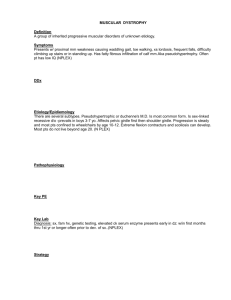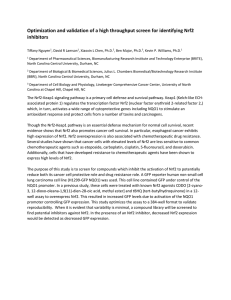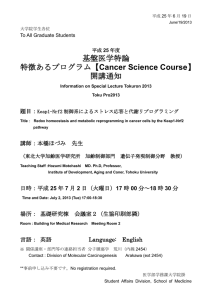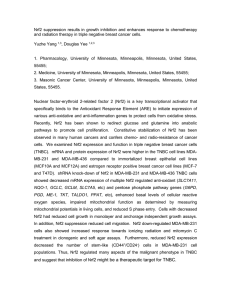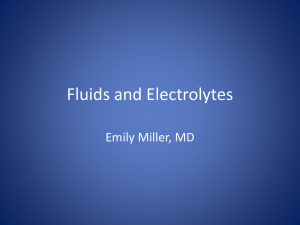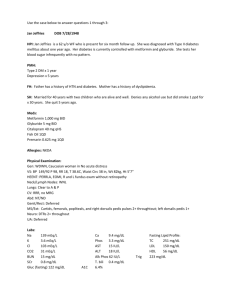Loss Of Nrf2 Dependent Signaling Following Induction of Endoplasmic Reticulum Stress
advertisement
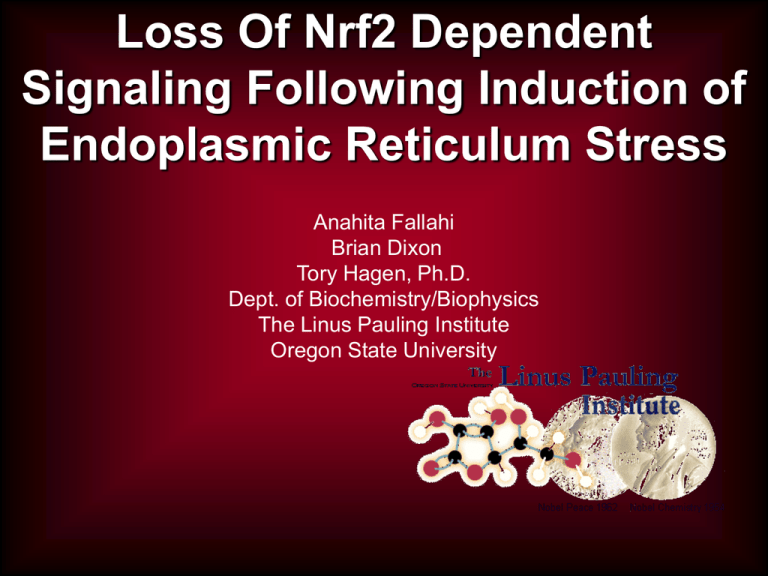
Loss Of Nrf2 Dependent Signaling Following Induction of Endoplasmic Reticulum Stress Anahita Fallahi Brian Dixon Tory Hagen, Ph.D. Dept. of Biochemistry/Biophysics The Linus Pauling Institute Oregon State University PRESENTATION OUTLINE 1.) Introduction – – – 2.) 3.) 4.) 5.) 6.) Endoplasmic Reticulum Endoplasmic Reticulum Stress Response Hypothesis Methods Results Conclusions Future Research Endoplasmic Reticulum (ER) • Membranous network within the cell that processes and folds 1/3 of all proteins. • The ER makes up approximately 12% of the cell’s volume. • The ER plays an important role in maintaining calcium homeostasis. • Anything that affects the ability of the ER to mature proteins can potentially damage the cell. ER Stress Results in the accumulation of unfolded/misfolded proteins which can threaten the cell. Causes •Disrupting calcium homeostasis •Virus •Oxidative Stress •Altered Glycosylation ER How do you deal with stress? ER Stress ER DEATH CELL RESPONSE Survival BiP Activates Kinase PERK Normal Conditions ER Stress Conditions BiP is released from PERK Bip binds to unfolded/misfolded proteins BiP BiP PERK PERK Phos Phos IRE 1 α IRE 1 α Phos Perk dimerizes and becomes phosphorylated. Cytoplasm Phos ER PERK eIF2α Nrf2 IRE 1 Phos Phos PERK-eIF2α Pathway Stress Conditions ER Normal Conditions eIF2α PERK Phos eIF2α eIF2α is phosphorylated preventing the formation of the translation complex. eIF2-GTP-tRNA Initiates Translation Cytoplasm Decreases the amount of total mRNA translation of proteins and reduces workload on stressed ER. It can now selectively translate specific mRNA. PERK-Nrf2 Pathway Stress Conditions ER Normal Conditions Nucleus PERK Phos Phos Nrf2 Keap 1 Nrf2 Nrf2 is phosphorylated and dissociates from Keap 1 Nrf2 is bounded to the cytoskeleton anchor Keap 1 leaving Nrf2 inactive Cytoplasm Keap 1 Nrf2 translocates to nucleus Nrf2 Turns on Detoxification Genes Free Nrf2 enters nucleus and binds to ARE sequence (Antioxidant Response Element) Phos Nrf2 NQO1 ARE Cytoplasm GSH Nucleus Cytoplasm Promotes expression of phase 2 detoxification enzymes such as NQO1 and GSH that promote cell survival. ER PERK eIF2α Nrf2 IRE 1 Phos Phos Phos Phase II detoxification enzymes Decreased protein load NQO1 Phos IRE 1α-CHOP Pathway Stress Conditions ER ATF 4 IRE 1α Phos Phos IRE 1α phosphorylates the transcription factor ATF4 ATF4 translocates to the nucleus and upregulates the expression of the transcription factor CHOP I CHOP Nucleus Cytoplasm CHOP CHOP enters the nucleus and upregulates the expression of proapoptotic genes. Cytoplasm Nucleus Cytoplasm Pro-Apoptotic Genes ER PERK IRE 1 Phos Nrf2 SURVIVAL eIF2α Phos Phos Phos DEATH ATF 4 Phos Decreased protein load NQO1 CHOP ER stress is worth stressing over… ER stress has been linked to the following medical conditions: Parkinson’s Huntington’s Alzheimer's Heart Disease A G E ER Stress Aging Do cells lose their ability to respond to ER stress with age? HHMI 2005 ER Stress Aging Hypothesis 1.) Cells are more susceptible to ER stress with age. 2.) Signaling between Nrf2 and PERK alters with age. Methods Old Hepatocytes Young Hepatocytes Tunicamyacin Western Blots QPCR NQO1 Phos Nrf2 eIF2α Nucleus Phos CHOP NQO1 mRNA Levels N.S. ** 0.3 450 400 N.S. 350 0.2 N.S. * 300 N.S. 250 200 0.1 150 100 0.0 0 4 12 24 0 4 12 24 0 4 12 24 0 4 12 Young Old Young Old Time (hrs) Time (hrs) Time (hrs) Time (hrs) N=3;*p<0.05 vs. Control; **p<0.01 vs. Control; N.S. (not significant) vs. Control 24 Phos Nrf2 Nrf2 Nuclear Localization Nucleus Nrf2 50000 300 * 40000 N.S. N.S. 30000 N.S. 250 200 N.S. 20000 150 N.S. 10000 100 0 0 4 12 24 0 4 12 24 0 4 12 24 0 4 12 Young Old Young Old Time (hrs) Time (hrs) Time (hrs) Time (hrs) N=3;*p<0.05 vs. Control; **p<0.01 vs. Control; N.S. (not significant) vs. Control 24 Conclusion ER PERK Still needs to be looked at eIF2α Nrf2 IRE 1 Phos Phos Phos Phos Decreases with age ATF 4 Phos Decreased protein load NQO1 CHOP Does not alter with age. Acknowledgements Special Thanks Dr. Tory Hagen Brian Dixon Dr. Kevin Ahern Oregon State University Dept. Biochemistry/Biophysics The Hagen Lab Brian Dixon Sesha Duvvuri Tory Hagen Du Heath Alex Michels Jeff Monette Regis Moreau Kate Peterson-Shay Swapna Shenvi Funding Agency Howard Hughes Medical Institute (HHMI)
